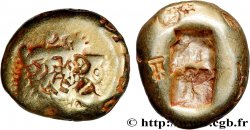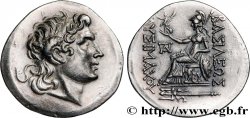v60_0005 - LIDIA - REGNO DI LIDIA hemi-hecte
MONNAIES 60 (2013)
Начальная цена : 950.00 €
Назначить цену : 1 500.00 €
Цена реализации : 1 310.00 €
Количество ставок : 3
Максимальная предлагаемая цена : 1 315.00 €
Начальная цена : 950.00 €
Назначить цену : 1 500.00 €
Цена реализации : 1 310.00 €
Количество ставок : 3
Максимальная предлагаемая цена : 1 315.00 €
Тип hemi-hecte
Дата: c. 610-550 AC.
Монетный двор / Город: Sardes, Lydie
Металл: electrum
Диаметр: 8 mm
Ориентация осей монеты: - h.
Вес: 1,18 g.
Редкость: R2
Комментарии о состоянии
Exemplaire sur un flan ovale, bien centré avec une usure régulière, parfaitement identifiable. Carré creux très intéressant au revers. Jolie couleur jaunâtre faisant penser à de l’or
Ссылки в каталоге: :
BMC.8 (Lydie) - P.- - Aulock- - GC.3402 (300£) - Rosen654 - Dewing- - B. traité- pl. 2/ - Lockett2978
Происхождение:
Cet exemplaire provient de la vente Vinchon du 27 octobre 2000, n° 219 et de la collection D. R.
Лицевая сторона
Аверс: легенда: ANÉPIGRAPHE.
Аверс: описание: Tête de lion à droite, verrue sur le front (étoile).
Обратная сторона
Реверс: Описание: Double carré creux informe.
Комментарий
Nous n’avons pas relevé d’identité de coin pertinente pour ce type qui semble néanmoins plus rare que ne le laissent supposer les principaux ouvrages de numismatique. C’est la deuxième fois que nous proposons ce type en vente sur offres qui est un véritable petit monument, précurseur de la numismatique.








 Cообщить об ошибке
Cообщить об ошибке Распечатать страницу
Распечатать страницу Отправить мой выбор
Отправить мой выбор Задать вопрос
Задать вопрос Consign / sell
Consign / sell
 Информация
Информация















